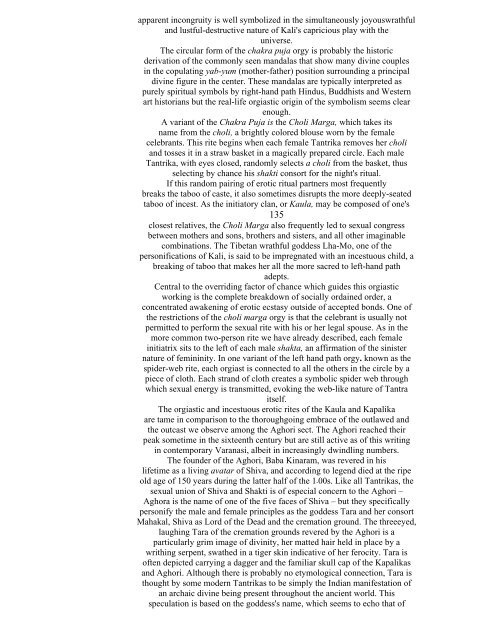I. VAMA MARGA Foundations Of The Left-Hand Path - staticfly.net
I. VAMA MARGA Foundations Of The Left-Hand Path - staticfly.net
I. VAMA MARGA Foundations Of The Left-Hand Path - staticfly.net
Create successful ePaper yourself
Turn your PDF publications into a flip-book with our unique Google optimized e-Paper software.
apparent incongruity is well symbolized in the simultaneously joyouswrathful<br />
and lustful-destructive nature of Kali's capricious play with the<br />
universe.<br />
<strong>The</strong> circular form of the chakra puja orgy is probably the historic<br />
derivation of the commonly seen mandalas that show many divine couples<br />
in the copulating yab-yum (mother-father) position surrounding a principal<br />
divine figure in the center. <strong>The</strong>se mandalas are typically interpreted as<br />
purely spiritual symbols by right-hand path Hindus, Buddhists and Western<br />
art historians but the real-life orgiastic origin of the symbolism seems clear<br />
enough.<br />
A variant of the Chakra Puja is the Choli Marga, which takes its<br />
name from the choli, a brightly colored blouse worn by the female<br />
celebrants. This rite begins when each female Tantrika removes her choli<br />
and tosses it in a straw basket in a magically prepared circle. Each male<br />
Tantrika, with eyes closed, randomly selects a choli from the basket, thus<br />
selecting by chance his shakti consort for the night's ritual.<br />
If this random pairing of erotic ritual partners most frequently<br />
breaks the taboo of caste, it also sometimes disrupts the more deeply-seated<br />
taboo of incest. As the initiatory clan, or Kaula, may be composed of one's<br />
135<br />
closest relatives, the Choli Marga also frequently led to sexual congress<br />
between mothers and sons, brothers and sisters, and all other imaginable<br />
combinations. <strong>The</strong> Tibetan wrathful goddess Lha-Mo, one of the<br />
personifications of Kali, is said to be impregnated with an incestuous child, a<br />
breaking of taboo that makes her all the more sacred to left-hand path<br />
adepts.<br />
Central to the overriding factor of chance which guides this orgiastic<br />
working is the complete breakdown of socially ordained order, a<br />
concentrated awakening of erotic ecstasy outside of accepted bonds. One of<br />
the restrictions of the choli marga orgy is that the celebrant is usually not<br />
permitted to perform the sexual rite with his or her legal spouse. As in the<br />
more common two-person rite we have already described, each female<br />
initiatrix sits to the left of each male shakta, an affirmation of the sinister<br />
nature of femininity. In one variant of the left hand path orgy. known as the<br />
spider-web rite, each orgiast is connected to all the others in the circle by a<br />
piece of cloth. Each strand of cloth creates a symbolic spider web through<br />
which sexual energy is transmitted, evoking the web-like nature of Tantra<br />
itself.<br />
<strong>The</strong> orgiastic and incestuous erotic rites of the Kaula and Kapalika<br />
are tame in comparison to the thoroughgoing embrace of the outlawed and<br />
the outcast we observe among the Aghori sect. <strong>The</strong> Aghori reached their<br />
peak sometime in the sixteenth century but are still active as of this writing<br />
in contemporary Varanasi, albeit in increasingly dwindling numbers.<br />
<strong>The</strong> founder of the Aghori, Baba Kinaram, was revered in his<br />
lifetime as a living avatar of Shiva, and according to legend died at the ripe<br />
old age of 150 years during the latter half of the 1-00s. Like all Tantrikas, the<br />
sexual union of Shiva and Shakti is of especial concern to the Aghori –<br />
Aghora is the name of one of the five faces of Shiva – but they specifically<br />
personify the male and female principles as the goddess Tara and her consort<br />
Mahakal, Shiva as Lord of the Dead and the cremation ground. <strong>The</strong> threeeyed,<br />
laughing Tara of the cremation grounds revered by the Aghori is a<br />
particularly grim image of divinity, her matted hair held in place by a<br />
writhing serpent, swathed in a tiger skin indicative of her ferocity. Tara is<br />
often depicted carrying a dagger and the familiar skull cap of the Kapalikas<br />
and Aghori. Although there is probably no etymological connection, Tara is<br />
thought by some modern Tantrikas to be simply the Indian manifestation of<br />
an archaic divine being present throughout the ancient world. This<br />
speculation is based on the goddess's name, which seems to echo that of
















